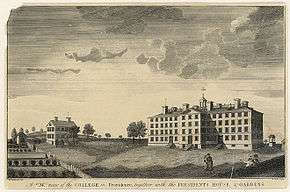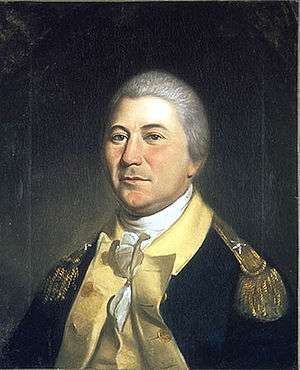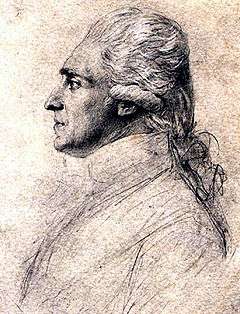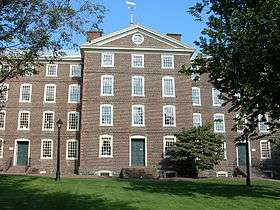University Hall (Brown University)
|
University Hall, Brown University | |
|
Front View | |
| Location | Providence, Rhode Island |
|---|---|
| Coordinates | 41°49′34″N 71°24′14″W / 41.82611°N 71.40389°WCoordinates: 41°49′34″N 71°24′14″W / 41.82611°N 71.40389°W |
| Built | 1770 |
| Architect | Robert Smith of Philadelphia |
| Architectural style | Georgian |
| Part of | College Hill Historic District (#70000019) |
| NRHP Reference # | 66000003 |
| Significant dates | |
| Added to NRHP | October 15, 1966[1] |
| Designated NHL | June 13, 1962[2] |
| Designated NHLDCP | November 10, 1970 |
The University Hall (1770) at Brown University is the first and oldest building on campus located in Providence, Rhode Island.
History
Built in 1770, it was originally known as the College Edifice. The building was constructed on a piece of land that had belonged to the original Brown family ancestor and co-founder of Providence, Chad Brown (c. 1600-1650).[3]
On February 17, 1770 the building committee in charge of the construction of the building placed a notice in the Providence Gazette asking for donations of timber and other materials. Prominent Newport merchant Aaron Lopez donated timber to the effort. On March 27, 1770, Solomon Drowne of Brown's class of 1773 wrote in his diary: “This day they began to dig the Cellar for the College.” Nicholas Brown, Sr. and Company led the construction of the building and his family donated the land. Morgan Edwards, described the location as “Commanding a prospect of ... an extensive country, variegated with hills and dales, woods, and plains,” and was further inspired to write, “Surely, this spot was made for a seat for the Muses.” [3]
Under the presidency of the Reverend James Manning, the building was used to house French and other revolutionary troops led by General George Washington and the Comte de Rochambeau during the wait to commence the celebrated march of 1781 that led to the Siege of Yorktown and the Battle of the Chesapeake.
Following the departure of the French troops, President Manning petitioned the Rhode Island General Assembly as follows:[3]
- “That the College edifice was first taken in December, 1776, for the use of barracks and a hospital for the American troops, and retained for that use until the Fall before the arrival of his most Christian Majesty’s fleets and armies in this State; – that, by our direction, the President resumed the course of education in said College, and took possession of the edifice on the 10th of May, 1780; and continued so to occupy it until the authority of this State, in a short time after, granted it to the French army as an hospital, who continued to hold and use it for said purpose until the last week, when the Commissary of War of the French army delivered it up, with the keys, to his Honor the Deputy Governor; they having previously permitted the officers of the French ships in this State to place their sick in it, who still continue there; – that the building was in good repair, and occupied by upwards of thirty students when first taken for the public service; – that great injury hath been done to every part of it since taken out of the hands of the Corporation; especially by two buildings adjoining it, one an house of offal at the north end, with a vault fifteen feet deep under it, having broken down the wall of the College to facilitate the passage of the invalids from the edifice into it; from which addition the intolerable stench renders all the northern part uninhabitable; and the other an horse stable, built from the east projection to the north end, by which the house is greatly weakened; many of the windows are also taken entirely out of the house, and others so broken, as well as the slate on the roof, that the storms naturally beat into it. ... “
On May 11, 1927, a tablet placed on University Hall was dedicated to the memory of General Nathanael Greene, who had received an honorary degree from Brown in 1776, by the First Light Infantry Regiment of Rhode Island.
During early 20th-century renovations, when the modern cupola was removed, remnants of the eight-sided original cupola were revealed, with the names of two former students and their classes, “Amos Hopkins 1792” and “Henry D’Wolfe 1803,” carved on one of its uprights.
At the rededication of University Hall on May 4, 1940, French ambassador Comte René Doynel de Saint-Quentin and Princeton president Harold W. Dodds took part in the ceremonies recalling the University’s early associations with France and Princeton.
The building has been used for many different purposes at the University over the years. It currently houses the office for the president of Brown on the first floor, facing the middle campus in space first occupied by the Commons, along with other administrative offices. The building was designated a National Historic Landmark in 1962, recognizing it as an excellent example of 18th-century academic architecture, and as key place in the life of educator Horace Mann (1796-1859), who graduated from Brown in 1819 and taught there until 1821, before embarking on a career of educational reform.[2][4]
Gallery

First Known Engraving (1795) 
A winter view (1997) 
Spring 2007 




See also
- List of National Historic Landmarks in Rhode Island
- National Register of Historic Places listings in Providence, Rhode Island
- List of historic sites preserved along Rochambeau's route
References
- ↑ National Park Service (2008-04-15). "National Register Information System". National Register of Historic Places. National Park Service.
- 1 2 "University Hall, Brown University". National Historic Landmark summary listing. National Park Service. Retrieved 2008-06-29.
- 1 2 3 From Martha Mitchell’s Encyclopedia Brunoniana: University Hall
- ↑ "NHL nomination for University Hall" (PDF). National Park Service. Retrieved 2014-11-01.
External links
- Encyclopedia Brunoniana
- Rhode Island Historical Society
- Society of the Cincinnati - library
- John Carter Brown Library
- French Naval Leaders and the French Navy in the American War for Independence
- Degrees of Latitude: Mapping Colonial America by Margaret Pritchard
- The Long March to Yorktown by Donald N. Moran
- Biography of Princeton University president Harold W. Dodds
- Historic American Buildings Survey (HABS) No. RI-283, "Brown University, University Hall, Prospect Street, Providence, Providence County, RI", 1 photo, supplemental material

